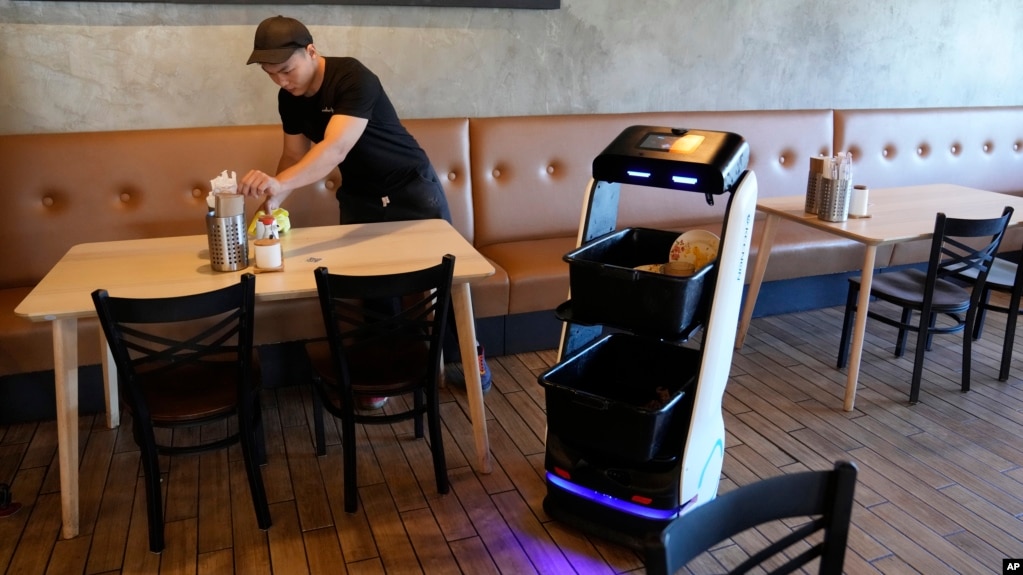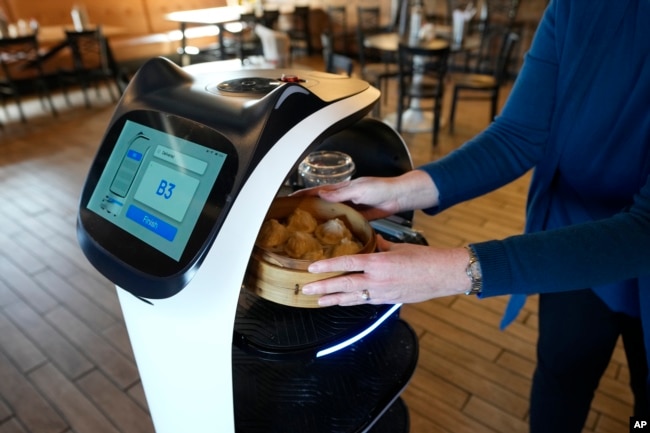Are Robot Waiters the Future?

You may have already seen them in some restaurants around the world: robots.
They are about the size of a child. They can welcome people and lead them to their tables. They can deliver food and drinks and bring dirty dishes back to the kitchen. Some have cat-like faces and even make noises when you scratch their heads.
But are robot waiters the future? It is a question the restaurant industry is trying to answer.
Many people think robot waiters are the answer to worker shortages. Sales of robots have been growing in recent years. There are tens of thousands of them now moving through eating places worldwide.
“There’s no doubt in my mind that this is where the world is going,” said Dennis Reynolds, head of the Hilton College of Global Hospitality Leadership at the University of Houston. The school’s restaurant began using a robot in December. Reynolds said it has eased the workload for humans and improved service.
But others say robot waiters still have a long way to go before they can replace humans. They cannot take orders. And they cannot walk up steps to different areas of a restaurant.
“Restaurants are pretty chaotic places, so it’s very hard to insert automation in a way that is really productive,” said Craig Le Clair from the advising company Forrester.
Still, the use of robots is growing.
California-based Bear Robotics introduced its Servi robot in 2021. The company expects to have 10,000 deployed by the end of this year in 44 U.S. states and overseas. In China, Shenzen-based Pudu Robotics, which was founded in 2016, has deployed more than 56,000 robots worldwide.
“Every restaurant chain is looking toward as much automation as possible,” said Phil Zheng of Richtech Robotics, a maker of robot servers based in Austin, Texas. “People are going to see these everywhere in the next year or two.”

A customer receives a meal delivered by a robot at the Noodle Topia restaurant on March 20, 2023 in Michigan. (AP Photo/Carlos Osorio)
In Madison Heights, Michigan, Li Zhai was having trouble finding workers for his restaurant Noodle Topia in the summer of 2021. So, he bought a robot from Pudu Robotics. The robot was so successful he added two more; now, one robot leads diners to their seats while another delivers food to tables. And his employees load dirty dishes onto a third robot to bring them back to the kitchen.
Zhai said he now needs three people to do the same work that five or six people used to do. And they save him money. A robot costs around $15,000, he said, but a person costs him $5,000 to $6,000 per month.
Zhai noted that the robots give his human servers more time to spend with diners, which increases tips. Tips are extra money given to food servers to reward them for their service. And diners often post videos of the robots on social media that lead to more visits. “Besides saving labor, the robots generate business,” he said.
Betzy Giron Reynosa at The Sushi Factory in West Melbourne, Florida said working with robots could be problematic. “You can’t really tell it to move or anything,” she said. She has also had diners who do not want to interact with it. But the robot is helpful, she said. It saves her trips to the kitchen and gives her more time with diners.
LeClair of Forrester said worker shortages have greatly increased the use of robot servers at restaurants.
In the U.S., the restaurant industry employed 15 million people at the end of last year. But that was 400,000 fewer than before the COVID-19 pandemic, the National Restaurant Association said. In a recent opinion study, 62 percent of restaurant operators told the association they do not have enough employees to meet their needs.
The use of technology, like QR codes, to order food also prepared people to accept robots. Karthik Namasivayam of Michigan State University’s Broad College of Business said, “Once an operator begins to understand and work with one technology, other technologies…will be much more readily accepted.”
Namasivayam said that public acceptance of robot servers is very high in Asia. For example, he said Pizza Hut has robot servers in 1,000 restaurants in China.
The U.S. was slower to use robot servers, but more restaurants are now testing them. Chick-fil-A is trying them at several restaurants around the country. The company said the robots have given human employees more time to serve and welcome guests.
But not all restaurants have had success with robots.
Chili’s introduced a robot server in 2020. The restaurant company expanded the test to 61 U.S. restaurants before suddenly halting last August. Chili’s found that the robot moved too slowly and got in the way of human servers. And 58 percent of guests surveyed said robots did not improve their overall experience.
Haidilao in China began using robots a year ago to take food to diners’ tables. But managers at several restaurants said the robots have not proved as dependable or cost-effective as human servers.
Wang Long, the manager of a Haidilao restaurant in Beijing, said his two robots have both broken down. “We only used them now and then,” Wang said, “…the machine can never replace humans.”
Words in This Story
dish–n. a flat container for holding and serving food
doubt –n. a feeling of being unsure or of disbelief
chaotic –adj. in complete disorder
automation –n. the use of machines rather than people
diner –n. a person who eats at a restaurant
QR code –n. a square picture that is read by a computer and which provide information about a product or process
guest –n. a person who goes to a restaurant or hotel and uses its services
Are Robot Waiters the Future? (voanews.com)